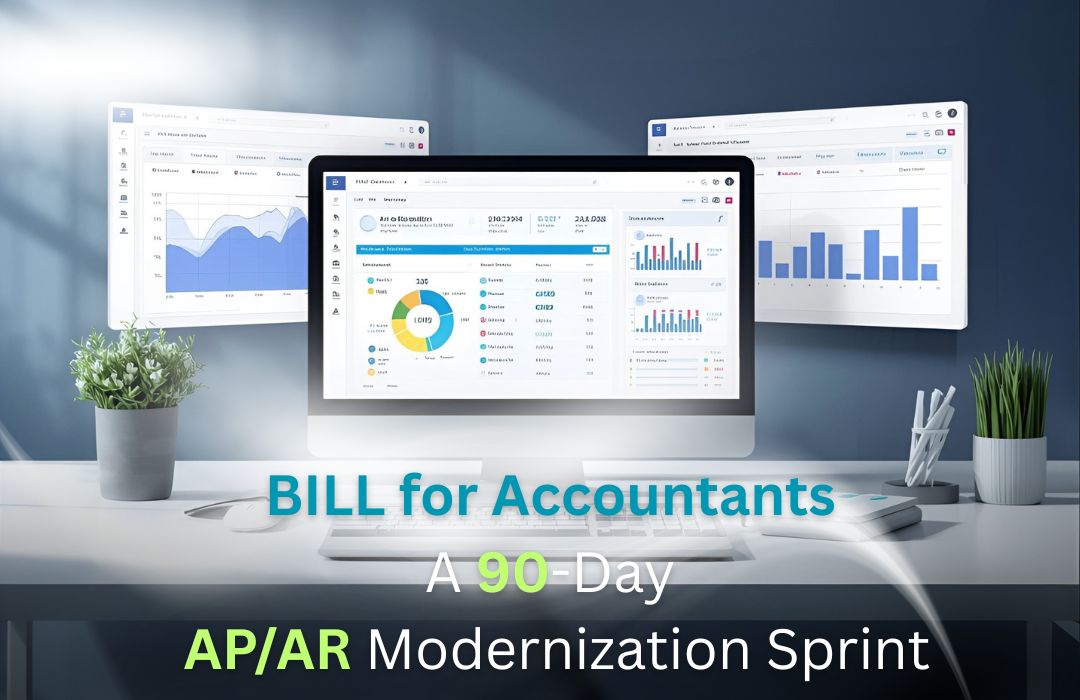
For most CPA firms running a Client Accounting Services practice, accounts payable and accounts receivable management can feel like a never-ending cycle of messy inboxes, delayed approvals, and frantic vendor follow-ups. You’ve probably seen it: a client forwarding 20 invoices in random formats, another chasing down late-paying customers, and your team scrambling to reconcile numbers before month-end. These bottlenecks don’t just slow down bookkeeping; they quietly eat into your margins, disrupt cash flow, and make scaling your CAS practice harder than it should be.
This is where BILL for Accountants steps in. Designed with CPA firms in mind, the BILL Accountant Console brings AP automation and AR modernization into one streamlined hub. Instead of juggling multiple portals or chasing down disconnected spreadsheets, firms can roll out a standardized AP/AR operating model across 20+ small business clients in as little as 90 days. The payoff? Better client visibility into spend and cash flow, stronger internal controls, and a CAS practice that’s easier to scale profitably.
That’s why more firms are turning to BILL for Accountants. With its Accountant Console, firms can standardize AP/AR workflows across 20+ SMB clients in just 90 days. The result? Faster approvals, better cash flow visibility, and a scalable CAS practice that delivers both efficiency and profitability.
In this guide, we’ll show you how to run a 90-day AP/AR modernization sprint using BILL, from sprint planning to KPIs, so your firm can move from chaos to consistency.
Let’s start with the big question:
Why does AP/AR Modernization Matter so much for CAS firms?
The truth is, AP/AR processes are often the most chaotic part of a small or mid-sized business. Invoices arrive by email, paper, or even text. Some vendors demand checks, while others push for ACH or card payments. Approvals often sit in someone’s inbox for days, and collections drag out far longer than they should. For firms managing dozens of SMB clients, these inefficiencies create massive duplication of effort.
Here’s how AP/AR standardization directly improves your bottom line:
- Less manual Labor: Your staff does not spend time on analysis and advisory because they are busy chasing down invoices or reconciling mismatched payments.
- Consistent Processes: All clients use a common playbook, which saves time on training and misunderstandings.
- Accelerated financial closes: With AP/AR software linked to QBO/Xero, the end of the month does not become a fire drill.
- Better customer satisfaction: Clients experience quicker invoice payments, less interest and more reliable cash flow.
- Growth Margin: With standardised AP/AR processes on 20+ clients, you can grow but do not have to add to headcount.
Pro Tip: Treat AP/AR as the foundation of your CAS model. Once it’s standardized, you’ll find it much easier to layer on higher-value services like cashflow forecasting, budgeting, and CFO advisory.
The 90-Day Sprint Plan
The concept of the universalization of AP/AR across several clients simultaneously may be daunting. The 90-day sprint model enters there. It is a systematic, recurring process that aims at transforming messy, manual processes into automated, standard procedures within three months for clients. The step-by-step process includes:
Weeks 1–2: Backlog & Discovery
This is your foundation stage. Think of it as “taking inventory” of the current situation.
- Gather all current AP/AR workflows for your each client.
- Take out vendor lists, payment methods, and approval flows.
- Identify Problems: Are invoices stuck with one approver? Are collections dragging beyond 45 days?
- Document key metrics: approval times, exception rates, DSO, and DPO.
Weeks 3–4: Vendor Onboarding
Once you understand the pain points, start onboarding vendors into BILL.
- Load vendor details and assign payment methods.
- Set up vendor communication to introduce the new process.
- Train clients on how vendors will submit invoices going forward.
- Ensure payment methods are working (ACH, check, card, as applicable).
Weeks 5–6: Approval Pathways
The construction of the structure is all here:
- Set up approval workflows according to each client’s policies.
- Configure role-based access where a single individual does not have the end-to-end process.
- Train approvers on how to use the dashboard of BILL to ensure cycle times are less than 48 hours.
- Add escalation rules to invoices so they do not get lost.
Weeks 7–8: Payment Runs & Receivables
Now the system starts moving real money:
- Begin AP payment runs directly in BILL.
- Enable AR automation: invoice creation, reminders, and collections.
- Monitor exception handling, flagging duplicates, mismatches, or vendor changes.
- Sync with QBO/Xero to keep books updated.
Weeks 9–10: Cashflow Visibility
When AP/AR is in operation, it is now time to create value for the clients.
- Implement dashboards that indicate the inflows and outflows in real time.
- Implement 13-week cash flow projections to allow clients to plan.
- With insights, you can make recommendations based on vendor term adjustments or collection planning.
Weeks 11–12: Reporting
The final stage is about refinement and demonstrating impact:
- The last phase is of refinement and proving impact.
- Review KPI improvement over baseline.
- Deliver client-friendly reports highlighting gains (faster collections, reduced approval times).
- Lock in standardized templates you can roll across your next batch of clients.
By the end of 90 days, you’ll have clients running on a consistent AP/AR operating model that is efficient, secure, and scalable.
What the BILL Accountant Console Really Brings to the Table
Think of the BILL Accountant Console as the mission control center for your firm’s AP/AR modernization sprint. As you don’t have to switch between multiple software tools, client portals, and spreadsheets, your work will be in one intuitive dashboard. This is where efficiency meets visibility. Here’s what firms gain with the console:
- One Login for All Clients
No more remembering dozens of passwords or hopping across platforms. With one secure login, you can move seamlessly from Client A’s invoices to Client B’s receivables without breaking your flow. For CAS directors handling 20+ SMB clients, this single feature alone can save hours each week.
- Centralized Task Lists
The console links to an up-to-date task list, eliminating the need for users to check emails or Slack threads for overdue invoices. You can instantly view what is pending, such as approvals, overdue payments or flagged exceptions, thus team management is less complicated and client communication quicker.
- Forecasting & Cashflow Insights
The console is not merely about bill management, but it also provides a financial roadmap the clients. Forecasting tools will assist you in determining when a client is likely to run out of cash or when he/she has an excess. Such understandings make you not only a processor but a reliable consultant who guides clients to make more intelligent business decisions.
- Automated Reminders
The console automates reminders so invoices don’t go unnoticed, reducing late fees and avoiding strained vendor relationships. Your clients see faster payments and healthier cash flow, and your team has to spend less time chasing approvals.
Put simply, the BILL Accountant Console is more than a management tool; it’s a value amplifier. It transforms how your firm delivers client service by elevating you from a transactional role into a strategic partner with real-time insights at your fingertips.
Important KPIs That Prove Modernization Works
To win client trust (and secure recurring advisory revenue), you need proof. KPIs are your evidence. You must have evidence to gain client confidence (and guarantee recurring advisory fees). KPIs are your evidence. The measurable effect of AP/AR modernization can be proved by calculating the right indicators.
-
Days Payable Outstanding
Monitors the payment time of clients to vendors. A balanced DPO handles cash conservation and ensures a good relationship with vendors. Excessive and vendors will become impatient, and clients will lose liquidity.
-
Days Sales Outstanding
Determines the speed of receivables collection. A decrease in DSO directly enhances the inflows. A decline of 10 days may be the difference between a borrowed loan and internal funding for many SMB clients.
-
Approval Times
What is the speed of invoice movement between invoice receipt and approval? Simpler operations and improved cash visibility are a result of faster approval cycles (less than 48 hours).
-
Exception Rate
This is the percentage of invoices that need manual review. A healthy goal is under 5%. Every percentage point reduction represents fewer bottlenecks and more automated efficiency.
Pro Tip: Always show clients a “before and after” KPI report. When they see DSO slashed by 20 days or approval cycles cut in half, the return on investment in your services is undeniable.
Security First: Protecting Client Data
AP/AR modernization introduces automation and cloud workflows, but it also comes with an obligation: safeguarding client data. Mishandling sensitive financials could cost your firm not just a client but its reputation. That’s why building security into every layer of the sprint is non-negotiable. Key practices include:
- Implement role-based access control because preparers, approvers, and payers have their limits.
- Allowing the use of multi-factor authentication (MFA) during each login to minimize unauthorised access.
- Installing vendor change controls to ensure fraudsters do not slip in false bank details.
- Consistent with the IRS Pub 4557 standards that outline the best practices for the protection of tax-related data.
- Through active integration of such controls, you not only lock up the assets of your clients, but also imply that your firm values compliance and trust.
Here is the Real Example…
Theory is great, but results speak louder. Here’s what happened when one CAS firm onboarded a 20-employee manufacturing business into the 90-day BILL sprint:
Starting Point (Baseline KPIs):
- DSO: 45 days
- Invoice approvals: 5–7 days
- Exception rate: 12%
After 90 Days:
- DSO reduced to 28 days (cash hitting accounts almost 3 weeks faster).
- Approvals completed in under 48 hours.
- The exception rate dropped to just 3%.
The client reported more reliable cash flow, stronger vendor relationships, and fewer late fees. For the firm, these results weren’t just impressive, they helped secure an expanded advisory contract.
Why This Matters for CAS Firms
Standardizing AP/AR processes isn’t about shaving minutes off workflows, it’s about building a scalable business model. When you remove manual bottlenecks, your staff can focus on higher-value advisory. When you improve client cashflow, you create loyalty. And when you rely on tools like the BILL Accountant Console, you gain a repeatable system that works across dozens of clients with minimal customization.
Wrapping Up:
AP/AR modernization isn’t a buzzword, it’s a competitive advantage. For CAS firms, the difference between simply “keeping the books” and being a strategic growth partner lies in how effectively you standardize, automate, and deliver insights.
The BILL Accountant Console brings all the moving parts together: centralized workflows, forecasting tools, automated reminders, and security protocols. It doesn’t just make processes smoother; it elevates the level of service you provide to clients. Couple that with a 90-day sprint plan, and you are not just cutting DSO, approval time and exceptions, but you are also providing clients with visibility of their cashflow and clarity of decision making.
Above all, it is not a single project. It’s a scalable model that can be applied to 20, 30, or 50 SMB clients across your firm. Every implementation makes you stronger, increases the strength of your relations with customers and helps to get new advisory opportunities.
The future of the client accounting service lies in the hands of the firms that accept standardization, automation and insight. You have the playbook, you have the platform, you have the proof points to get that future a reality, all in 90 days, with BILL to Accountants.
Frequently Asked Questions
Q1. What is BILL Accountant Console?
BILL Accountant Console is a CAS-centric platform. It provides accountants with a single account to operate with numerous clients, to oversee AP/AR processes, approvals, to predict cashflow, and to dispatch automatic reminders. This does away with the juggling spreadsheets or independent systems.
Q2. What does a 90-day AP/AR sprint accomplish for SMB clients?
An AP/AR modernization sprint can assist small and medium-sized businesses with a 90-day period of standardizing invoice approvals, payments to vendors and receipts collection. In three months, companies are able to shorten DSO, accelerate cash flows, strengthen supplier relationships, and provide customers with real-time cashflow information.
Q3. Which KPIs do firms monitor in case of AP/AR modernization?
Days Payable Outstanding (DPO), Days Sales Outstanding (DSO), approval times (less than 48 hours), and exception rate (less than 5 percent) are the most significant KPIs. Monitoring these indicators will justify automation and will offer quantifiable returns to clients.
Q4. What is BILL doing to enhance cashflow visibility to the clients?
BILL unites the AP/AR information between the vendors and customers and generates real-time spend, expense, and receivables dashboards. Companies are able to predict the level of liquidity, detect cash crunches before they occur and counsel clients to make financial decisions that are more prudent.
Q5. Is BILL secure to use with Accountants, regarding client data?
Yes. BILL applies very strict security controls, such as role-based access controls, multi-factor authentication (MFA), monitoring of vendor changes, and IRS Pub 4557 compliance. These are security measures that ensure that sensitive tax-related and financial information is not abused or misused.
Q6. Are the firms able to scale this AP/AR operating model among the many clients?
Absolutely. After developing the standardized workflows into BILL, the firms can deploy the same 90-day playbook to dozens of SMB clients with little customization. This brings about uniformity, effectiveness and scalability across the entire company.








